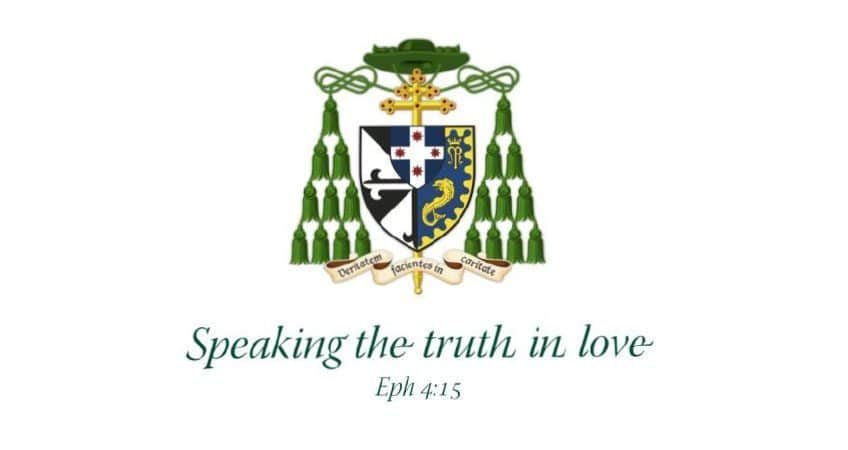HOMLY FOR MASS FOR 160TH ANNIVERSARY OF THE LAYING OF THE FOUNDATION STONE

Our Lady of Mt. Carmel, Waterloo
Earlier this year Charity Sunshine Tillerman Tillemann-Dick, a coloratura soprano, died aged 35. She had long struggled with idiopathic pulmonary hypertension that enlarged her heart to more than three times normal size and, in 2009 and again in 2012, she underwent double lung transplants. It was a tragically early death, but for Charity it was long enough for her to achieve her dream of singing the role of Violetta in La Traviata at the Lincoln Center. Ironically, however, the very thing that drove her to persevere through all her suffering may have contributed to her early death. One specialist warned that singing might add to the pressure on her heart and lungs. “Those high notes will kill you,” she said.[1]
Undaunted, Charity went on to sing her way through three sets of lungs and perform at the Capitol and the Kennedy Center, in the National Symphony Hall in Budapest and the American Embassy in Beijing, before eventually succumbing to terminal cancer. In her memoir she wrote: “When I sing, it is a joyous communion with God.”[2] This connection between her art and God’s grace was one she felt strongly and, in a 2017 interview with NPR, she said “for me, singing with someone else’s lungs, it never lets me forget that I’m not the one who’s in charge, whether you call it fate or chance or God.”[3]
Charity loved music so much she was unwilling to give it up, no matter the cost. But beyond, before or behind this was her sense of vocation as she strived to be a voice for God and demonstrate gratitude to her organ donors and health professionals.
For Charity, if her lungs wouldn’t let her sing, they were pointless. For Jesus, if a vine grafted onto Him is fruitless vine, it is devoid of meaning; indeed, it might as well be cut off and thrown in the fire (Jn 15:1-8). As Charity put it, “We all have a reason that we’re here. We all have a song to sing, whether its musical or not. And I am very conscious of the fact that I am one of the human embodiments of my organ donor’s life.” So, just as singing was, for her, a communion with God and her benefactors, so too was it the fruit she had to bear for others, her calling, her gift to the world.
St Luke’s rather romanticized description of the early church in our first reading (Acts 2:42-7) is taken by some to indicate that the first Christians lived in a kind of hippy commune, as proto-communists. Certainly it captures something of the all-in-ness of fervent new Christians. On the day the foundation stone of this church was laid, the Archbishop and clergy contributed £125 from their personal funds (which were not great) and the (mostly) poor Catholic laity another £230 – underlining that Christians have always known that our wealth and labour are God’s gifts to us so we might render them back to God. Not as a tax, mind you, compulsorily acquired; but as a donation freely given in love and gratitude.
The early Christians were no communists. They were something much harder to create, something much deeper: they were a community. Sadly, that word is thrown about so much today as to have been evacuated of any serious content: people talk of the sex-worker community, the hay-fever sufferers community, the rugby league community and so on. So perhaps a better word for us to use is communion. It’s no accident that Charity Tillemann-Dick used that word herself. Or that we use it to describe our union with God and each other at Mass. Holy Communion says everything meaningful that ‘community’ says, and so much more. A true communion could not abide some people being needlessly destitute while others were excessively comfortable, not because of a desire to make everyone ‘equal’ but because fraternal love drives those with more to help those with less, and all members to bear fruit, fruit that will last.
The poor can do that as well as the rich. Our young soprano shows that what we give the world is not always financial. Her gift was music, and an inspiring spirit. It was given to God and humanity in gratitude. So, too, those first disciples in Jerusalem shared all they had in common and worshipped together at the Temple. By adding worship to their giving, divine charity to human, they rendered their community a true communion.
I said at Fr Paul’s installation Mass last year that I hoped that the coming together of these three parishes and re-imagining of the mission will bear great fruits, including new adventures in Catholic worship and prayer, evangelization and formation, in early childhood, primary and secondary school education, in outreach to the First Australians, in health, aged care and social welfare, in youth ministry and more. There is so much still to be done for God and people in Waterloo-Green Square-Roseberry-Redfern! Tonight, as we celebrate 160 years of this church and parish, through its many changes, we ask God to renew in us that enthusiastic spirit of the first Christians of Jerusalem and first Catholics of Waterloo. We rededicate ourselves to bearing fruit for our community, to caring especially for the marginalised and giving what is needed. And we sing with the enthusiasm of Charity in gratitude for the gifts of lungs and hearts, of bodies and souls, of family and friends, of parish and country. I look forward to the harvest from this true vine of Jesus Christ in Waterloo and beyond.
Ad multos annos!
INTRODUCTION TO MASS FOR 160TH ANNIVERSARY OF THE LAYING OF THE FOUNDATION STONE
Our Lady of Mt. Carmel, Waterloo
Merchant and magistrate, politician and first speaker of the Legislative Assembly of New South Wales, university senator and world-leading stamp collector, Daniel Cooper was also a philanthropist, in recognition of which he was created hereditary baronet of Woollahra and ultimately Knight Grand Cross of the Order of St Michael and St George! Amongst his charitable deeds was donating more than an acre of land so that my venerable predecessor, Archbishop John Bede Polding, might erect a church at Waterloo. 160 years ago this week, Polding laid the foundation stone for a church big enough to “accommodate from 1500 to 2000 persons”[i] – I guess people were smaller in those days!
Waxing lyrical, the Freeman’s Journal, forerunner of our Catholic Weekly, declared:“Perhaps no more beautiful and commanding site upon which to build a house for the worship of the Most High God can be found in the whole world that that [for] the Church of Our Lady of Mount Carmel… at Waterloo.” From it could be spied “hill and dale, wood and water, winding, dusty roads, green and cultivated valleys, arid sand hills… in almost every direction.”[ii] Yet it was already a growing area, with “hundreds of habitations springing up on every side and every appearance of life and animation”.[iii]
The Archbishop’s carriage arrived, and “as he ascended the hill and entered the tent… erected for the occasion, we saw the tear glisten in many an eye, and heard many a fervent ‘God bless him’ uttered by old and young,” the paper continued. Having assumed the pontificals, His Grace led the clergy and attendant boys in their chants and lowered the foundation stone into place. There were further benedictions, hymns and processions, then “an impressive exhortation” by Polding.[iv] I’m not sure if I can match the style and gravity tonight!
Only two years later, Polding was back to bless the incompletely completed church.[v] It was an extraordinary achievement for the poor colonial Catholics and their friends. 160 years on, the “green and cultivated valleys” have been superseded by tower blocks, but after some separation the peoples of Waterloo, Redfern, and Roseberry, have rejoined as the one family they were back then. I welcome your pastor Fr Paul Smithers, and his predecessor Monsignor Greg Flynn, special guests, and parishioners past and present. To everyone: a very warm welcome!
[i] “New Catholic Church,” Freeman’s Journal 17 August 1859, p. 3.
[ii] “The Church of Our Lady of Mount Carmel,” Freeman’s Journal 3 April 1861, p. 4.
[iii] “New Catholic Church,” Freeman’s Journal 17 August 1859, p. 3.
[iv] “New Catholic Church,” Freeman’s Journal 17 August 1859, p. 3.
[v] “Opening of the Church of Our Lady of mount Carmel,” Freeman’s Journal 10 April 1861, p. 4.
[1] “Charity Tillemann-Dick: After a lung transplant, an aria”; https://www.youtube.com/watch?v=zvwQXwJyaj0; Emily Langer, “Charity Tillemann-Dick, operatic soprano who drew life and music from transplanted lungs, dies at 35”, Washington Post, 24 April 2019.
[2] Charity Sunshine Tillemann-Dick, The Encore: A Memoir in Three Acts (Atria Books, 2017).
[3] Scott Simon, “Interview of Charity Sunshine Tillemann-Dick,” NPR September 30 2017 https://www.npr.org/books/authors/554534068/charity-tillemann-dick

